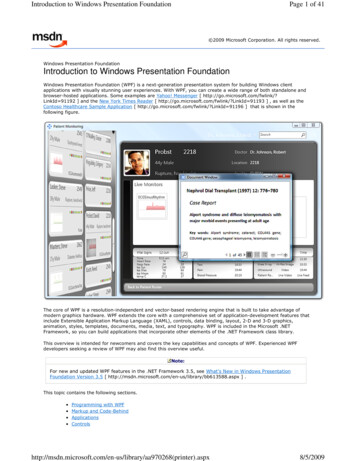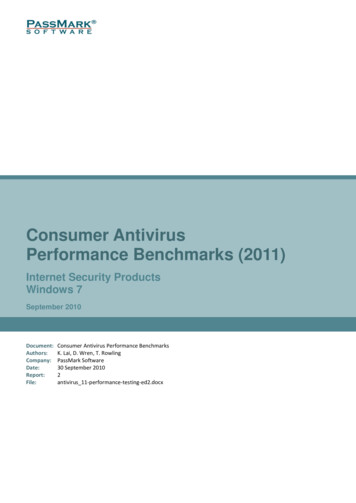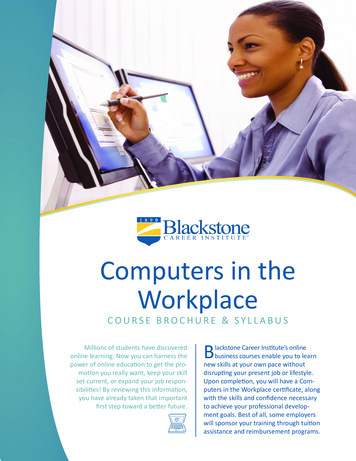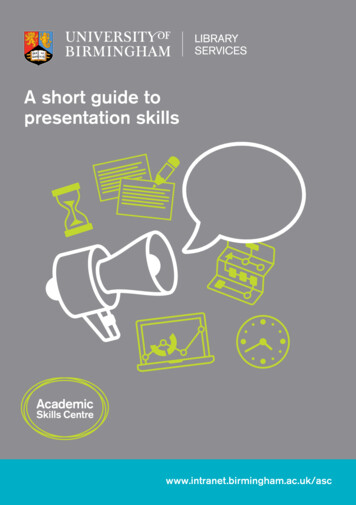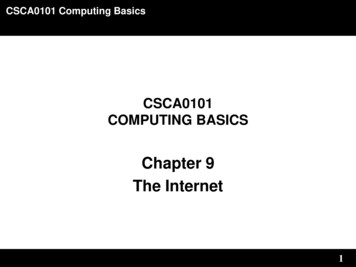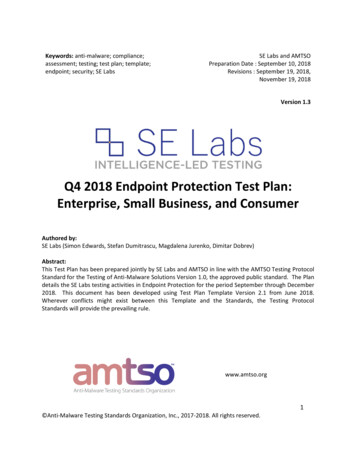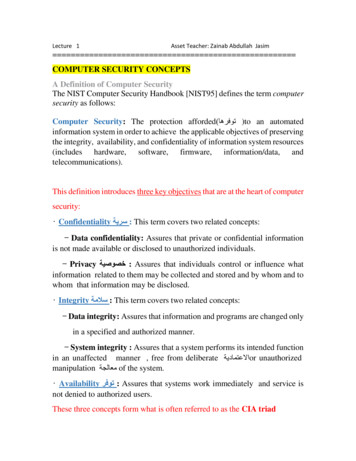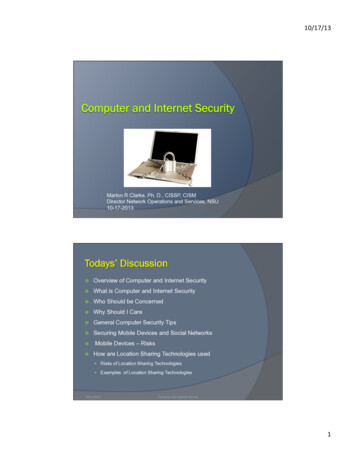
Transcription
10/17/13Marlon R Clarke, Ph. D., CISSP, CISMDirector Network Operations and Services, NSU10-17-2013Todays’ Discussion Overview of Computer and Internet Security What is Computer and Internet Security Who Should be Concerned Why Should I Care General Computer Security Tips Securing Mobile Devices and Social Networks Mobile Devices – RisksHow are Location Sharing Technologies used Risks of Location Sharing Technologies Examples of Location Sharing Technologies10/17/2013Computer and Internet Security1
10/17/13What is Computer and Internet Security Computer Security Protecting computers, information, and services fromunauthorized access, change or destruction. Internet security extends this concept to systems that areconnected to the Internet Browsing the Internet Electronic Commerce Social Networking Emailing10/17/2013Computer and Internet SecurityMarlon R Clarke, Ph. D., CISSP, CISMDirector Network Operations and Services, NSU10-17-20132
10/17/13Todays’ Discussion Overview of Computer and Internet Security What is Computer and Internet Security Who Should be Concerned Why Should I Care General Computer Security Tips Securing Mobile Devices and Social Networks Mobile Devices – RisksHow are Location Sharing Technologies used Risks of Location Sharing Technologies Examples of Location Sharing Technologies10/17/2013Computer and Internet SecurityWhat is Computer and Internet Security Computer Security Protecting computers, information, and services fromunauthorized access, change or destruction. Internet security extends this concept to systems that areconnected to the Internet Browsing the Internet Electronic Commerce Social Networking Emailing10/17/2013Computer and Internet Security3
10/17/13Who Should be concernedAnyone who uses Computers Mobile Devices The Internet Email Social Networks10/17/2013Computer and Internet SecurityWhy Should I Care? Infections from viruses, spyware, ormalware Virus - Program designed to infect yourcomputer, replicates itself , and usually causeslost or corrupt dataats code th youuiocliamhoutpe ofre is a ty on the internet wit Spywanalur habitscts persoelltracks yoocyllit; usuaknowingoninformati10/17/2013Computer and Internet Security4
10/17/13Why Should I Care. Cont’d Phishing, Hoaxes, Malware, Scams and Spam The most prevalent and persistent threats to your securitycome to you in your Inbox. They come by different namesand may even appear legitimate and even supposedlyfrom people you may know. They all have this in common: they are designed to getyou to click on an item like an attachment, link or picture.10/17/2013Computer and Internet SecurityWhy Should I Care. Cont’d Broken device Devices that do not work when needed oras expected. Privacy and personal security concerns Preventing private,personal, or sensitiveinformation from beingdisclosed10/17/2013Computer and Internet Security5
10/17/13Basic Approaches to Security Use anti-virus and anti-spyware Software Detects and removes viruses and spywarefrom your computer Must be kept up to dateInstall security patches Enable Firewalls Protects computers by preventingunauthorized access10/17/2013Computer and Internet SecurityBasic Approaches to Security Use strong passwords to protect computersBe cautious about downloading free software or filesfrom untrusted sitesMost prevalent threats to your securitycome to you in your Inbox; are all designedto get you to click on an item like anattachment, link or picture.If you click, you could launch harmfulprograms or be directed to a harmful website.10/17/2013Computer and Internet Security6
10/17/13Basic Approaches to Security Think before you click on links Most threats are targeted in hopes that you will click on aharmful link, attachment, picture, video or icon in an email orweb page Stop: Do not automatically click on Internet links until youhave confidence in them. Think: Look at the actual address for the links in question.For instance if the link indicates “Click Here” be sure tohover your mouse pointer over the link and investigatebefore you proceed. Click: Only after you are confident that thesite is safe.10/17/2013Computer and Internet SecuritySecurity for Mobile Devices and SocialNetworks Mobile Devices have become the devices of choice forcommunicating and connecting to the Internet Smartphones Tablets Laptop Computers Social Networks Foursquare, Google Latitude, Twitter Facebook, Google Pinterest, Gowalla10/17/2013Computer and Internet Security7
10/17/13Mobile Devices - Risks Mobile devices are easy to lose or steal Can carry large amount of data If stolen, an unsecured Smartphone grants accessto your private information: email correspondence,address books, and any unsecured documents. Often unprotected Data may be “sniffed” during unprotectedwireless communications10/17/2013Computer and Internet SecurityMobile Devices - Risks Location Sharing Location-aware applicationsdeliver online content to usersbased on their physicallocation. Technologies employ GPS,cell phone infrastructure orwireless access points toidentify where cell phones orlaptops are located and userscan share that informationwith location-awareapplications.10/17/2013Computer and Internet Security8
10/17/13Mobile Devices - How are LocationSharing Technologies used? Apps might provide you withinformation on nearbyrestaurants, notify you oftraffic jams, or let yourfriends in a social networkknow where you are,prompting increased socialconnectivity.10/17/2013Computer and Internet SecurityRisks of Location Sharing TechnologiesMakes users “human homing beacons” Increases the chances of being stalked May reveal when you are home or away 10/17/2013Computer and Internet Security9
10/17/13Examples of Location-SharingTechnologies GPS Geo-tagging of photos Location details added to photographs Facebook places Allows users to "share where you are with yourfriends, see where your friends are anddiscover new places around you.Blip – Blackberry application updateslocation every 15 minutes. Google Latitude – Allows you to seewhere your friends are and what they doing 10/17/2013Computer and Internet SecuritySecurity Guidelines for Location SharingTechnologies Most apps offer privacy controls –enable them Some privacy controls are not always easyto accessDefaults may be too open Know what applications you have andresearch privacy controls Disable GPS capabilities and geotagging features 10/17/2013Computer and Internet Security10
10/17/13Security Guidelines - Mobile Devices Enable auto-lock Enablepassword protection Keep the phone OS and apps up-to-date Enable remote wipe feature wherepossible Avoid connecting to public wirelessnetwork when possible.10/17/2013Computer and Internet SecuritySecurity Guidelines - Social Networks Security Guidelines Before you post, ask the following: Will this post/picture cause a problem for me? Would I say this in front of my mother? Limit the number of people that see it Share public information with the public Share inner thoughts and personal feelingswith close friends10/17/2013Computer and Internet Security11
10/17/13Security Guidelines - Social NetworksLimit your visibility on services Do not Friend or Connect with peoplethat you have not met in person or knowwell Limit your check-in information to friendsonly Never check in at your home, school,work A mayorship is a public “office” 10/17/2013Computer and Internet SecuritySecurity Guidelines - Social Networks Avoidpublic lists for a location Review posts you are tagged in Turn off geo location data in photos Turn off “find my face” in photos andvideos Disable location data for tweets Delete old location data too10/17/2013Computer and Internet Security12
10/17/13Stay SafeThink before you click and try to bemysterious when online10/17/2013Computer and Internet Security13
address books, and any unsecured documents. ! Often unprotected ! Data may be "sniffed" during unprotected wireless communications 10/17/2013 Computer and Internet Security Mobile Devices - Risks ! Location Sharing " Location-aware applications deliver online content to users based on their physical location.

